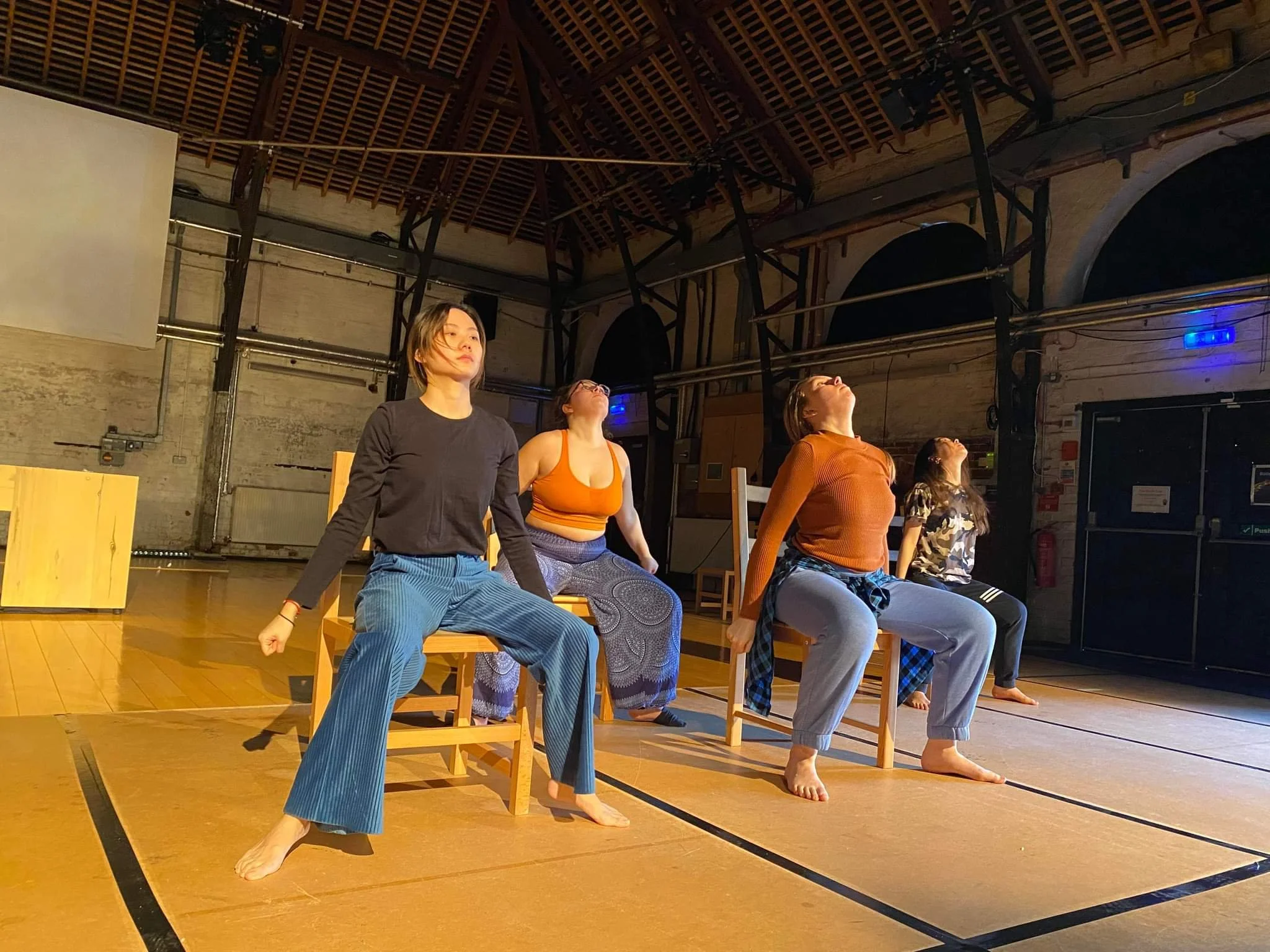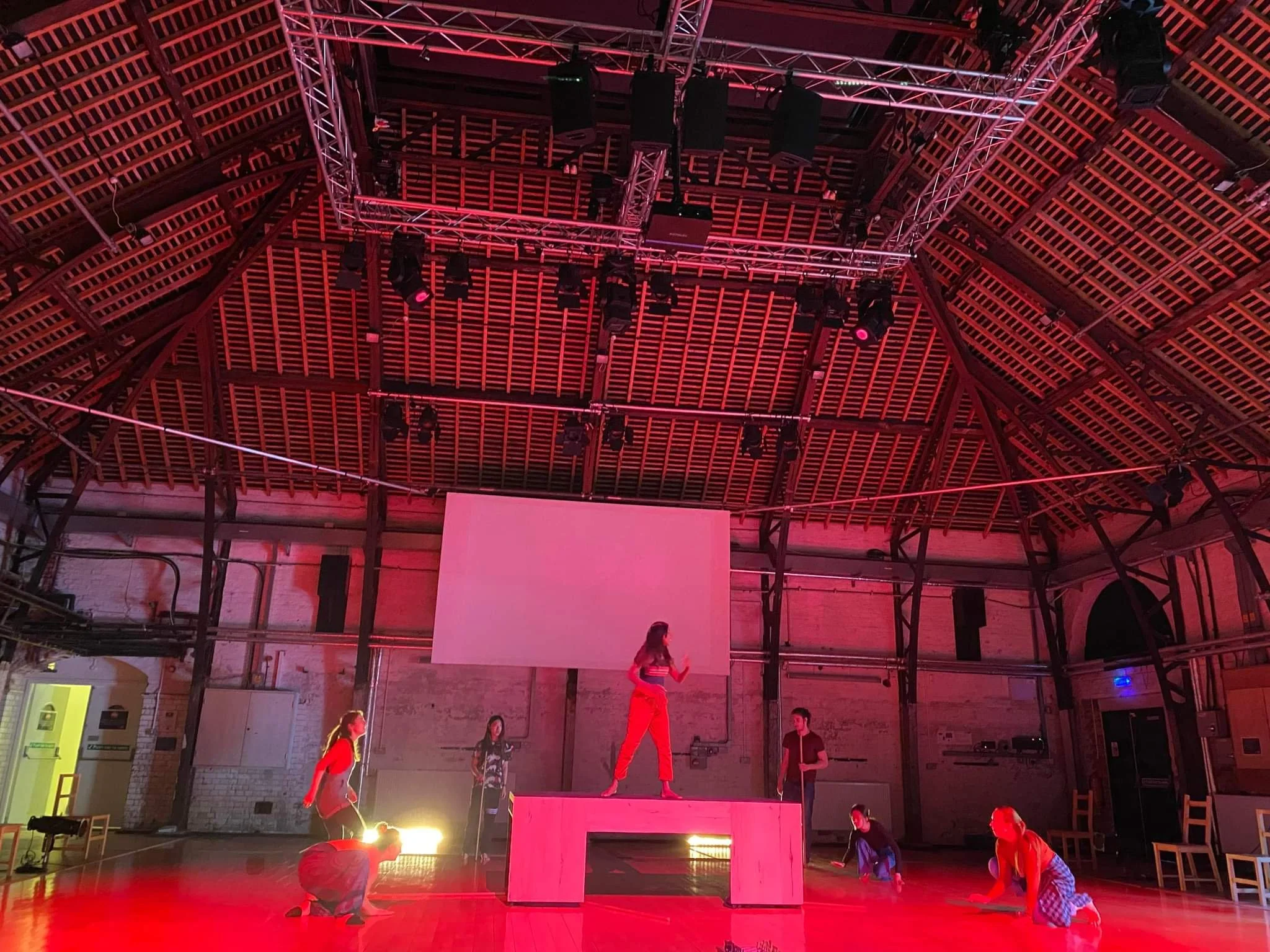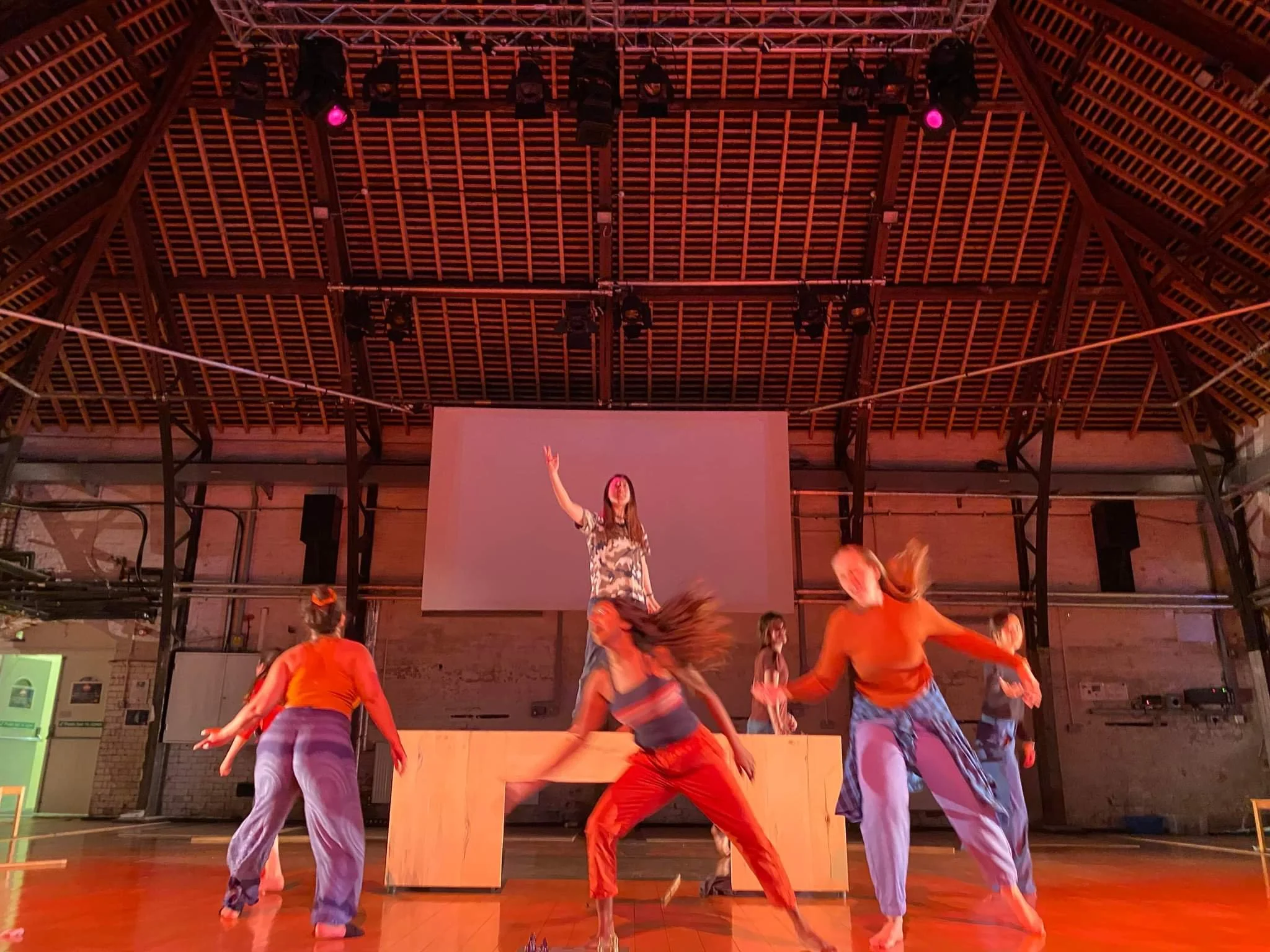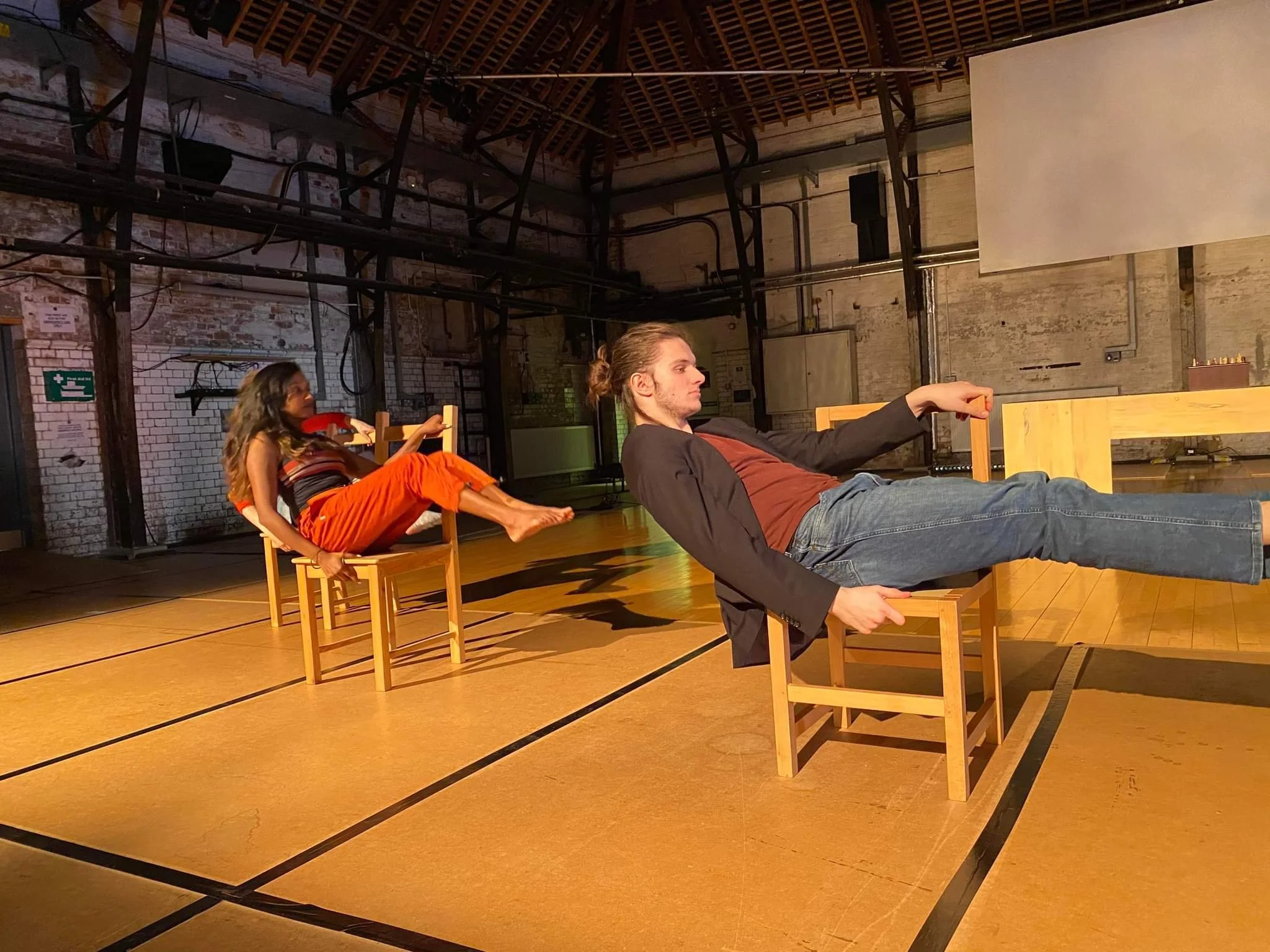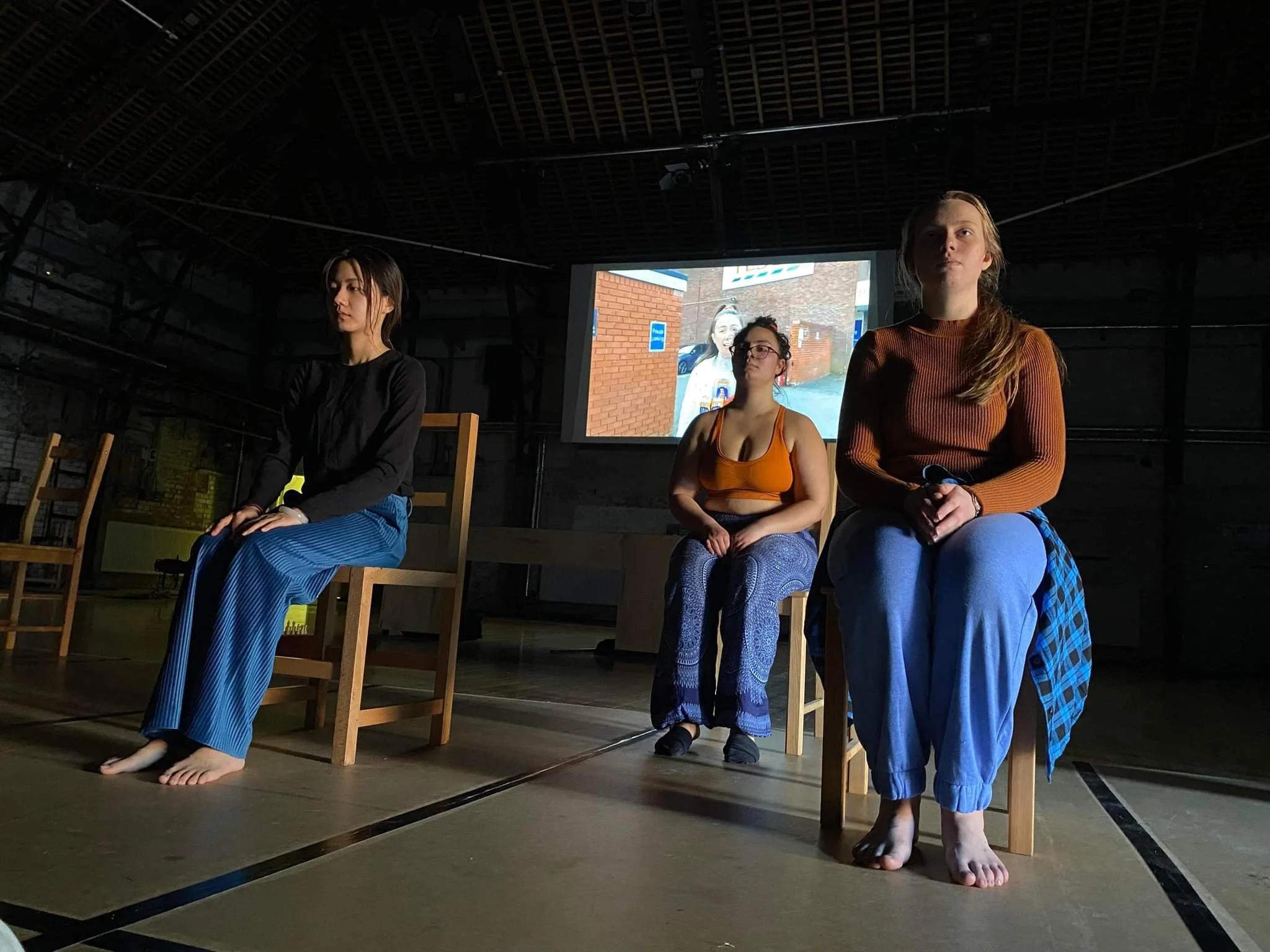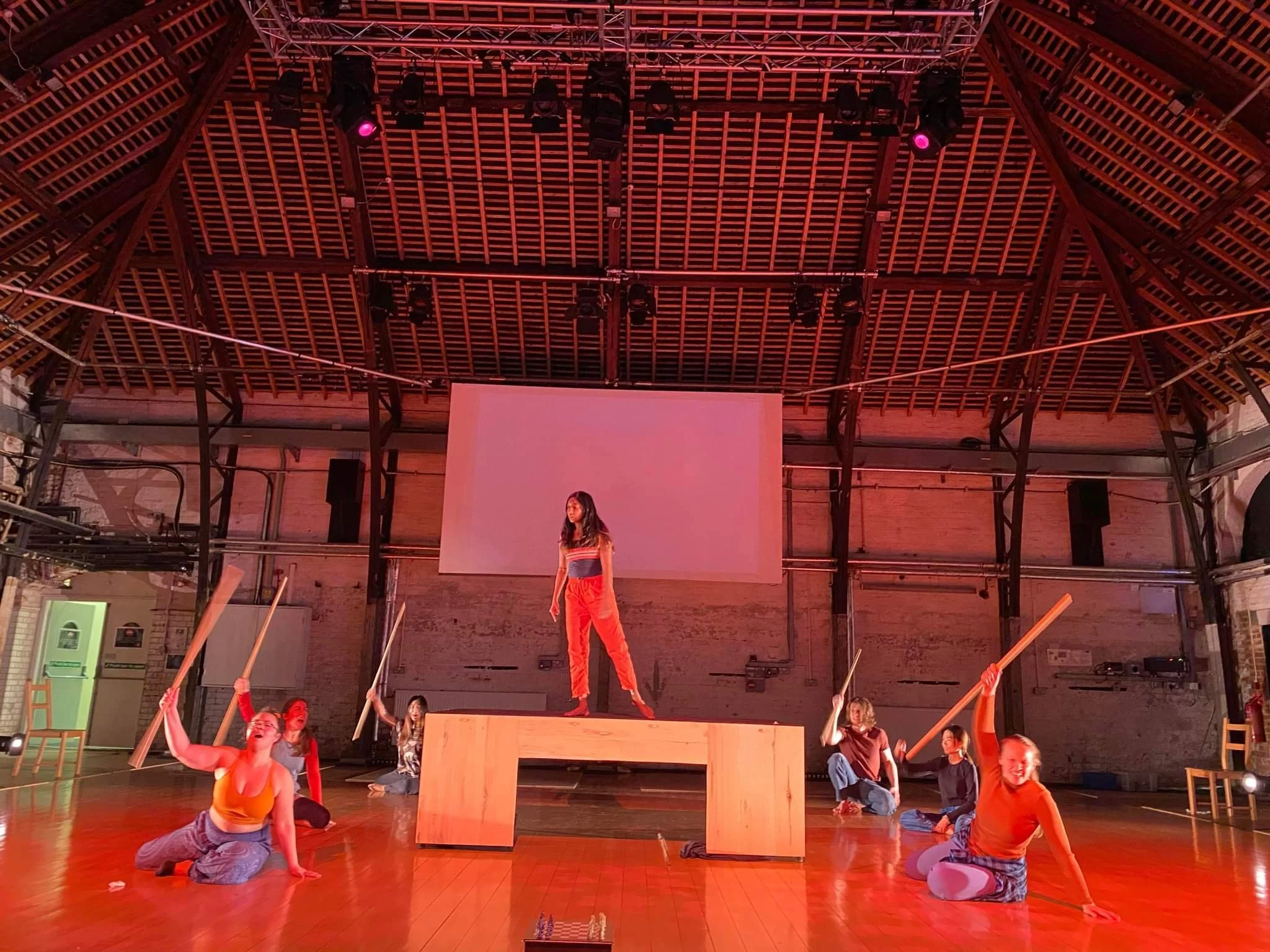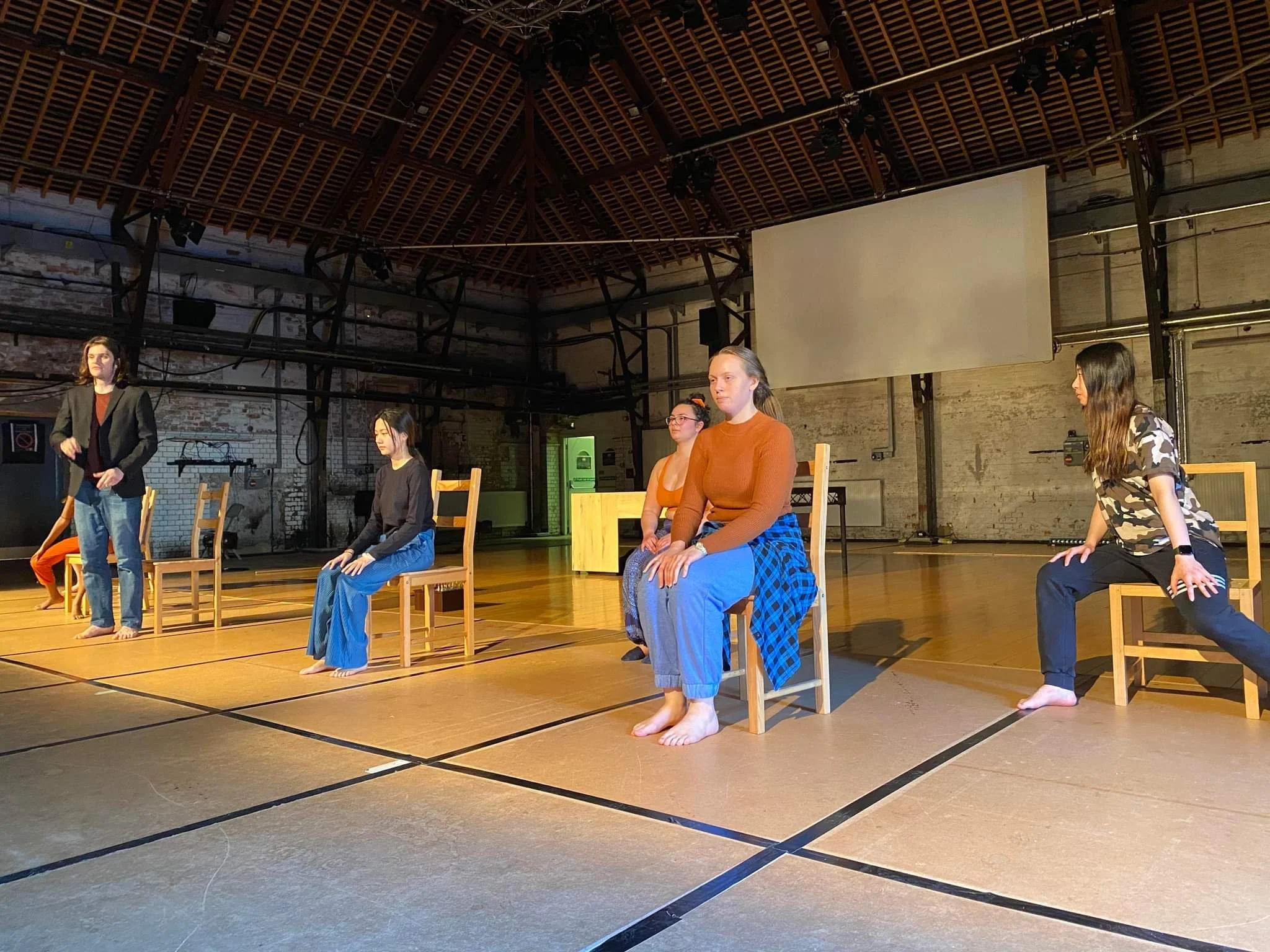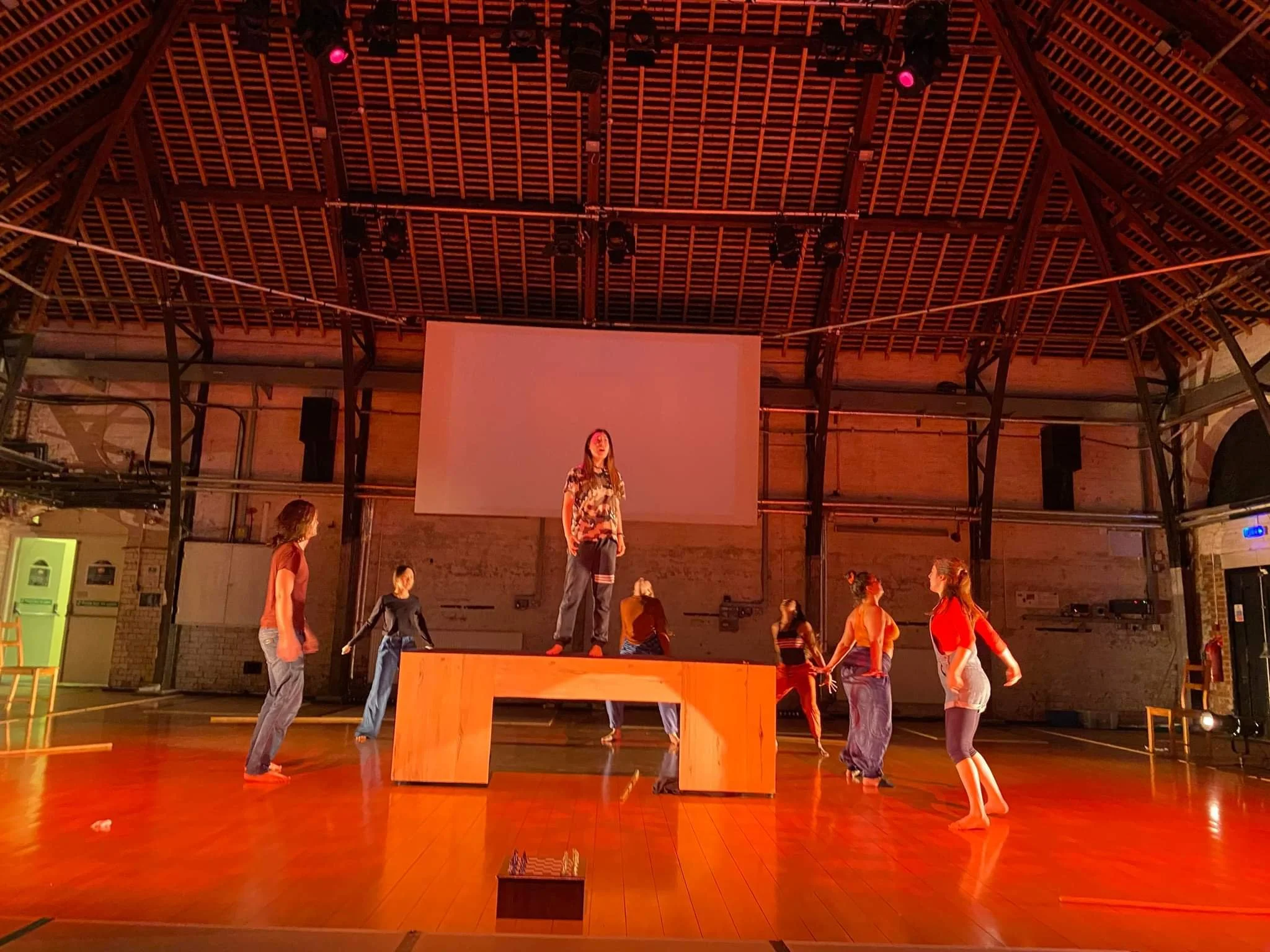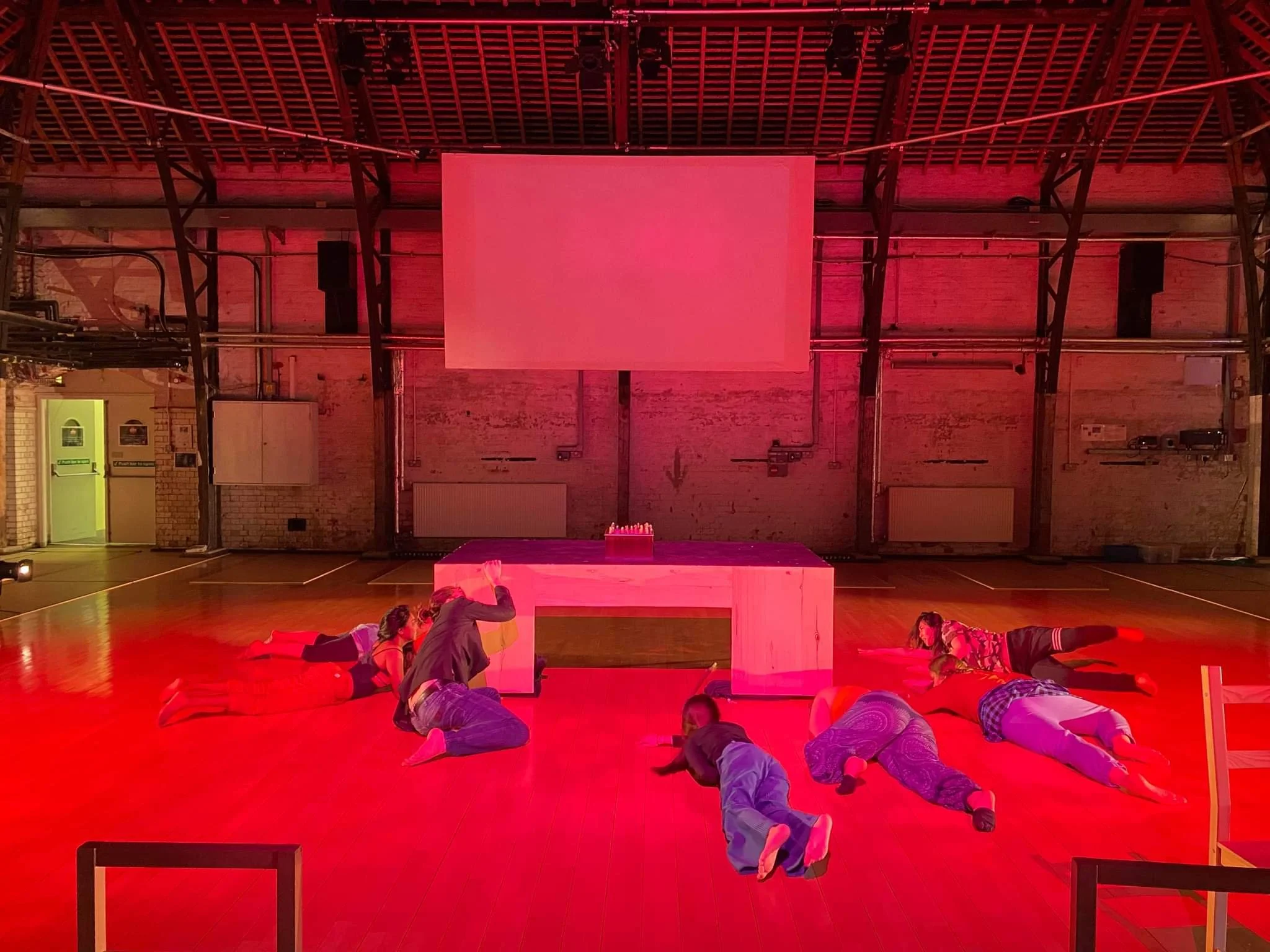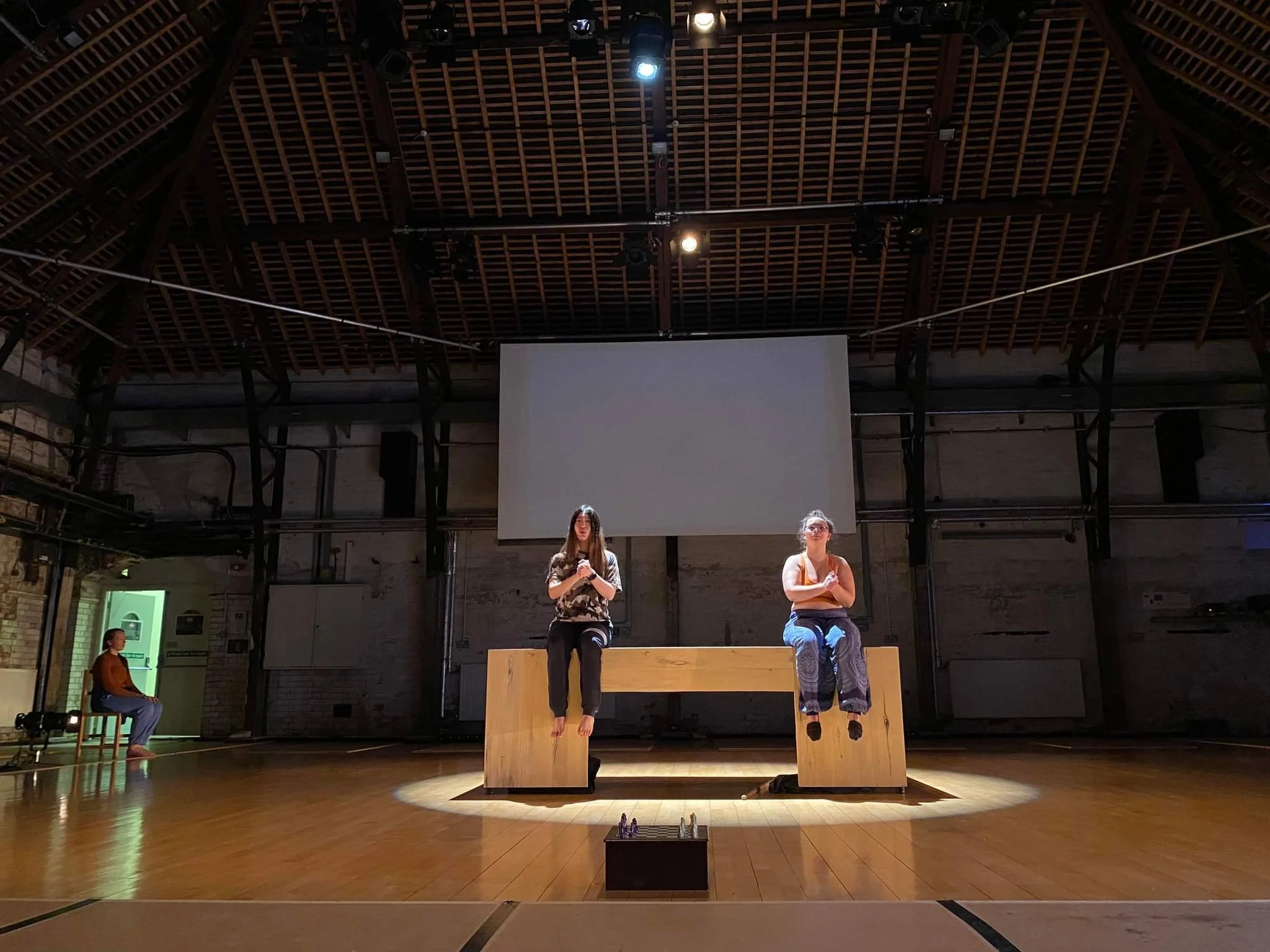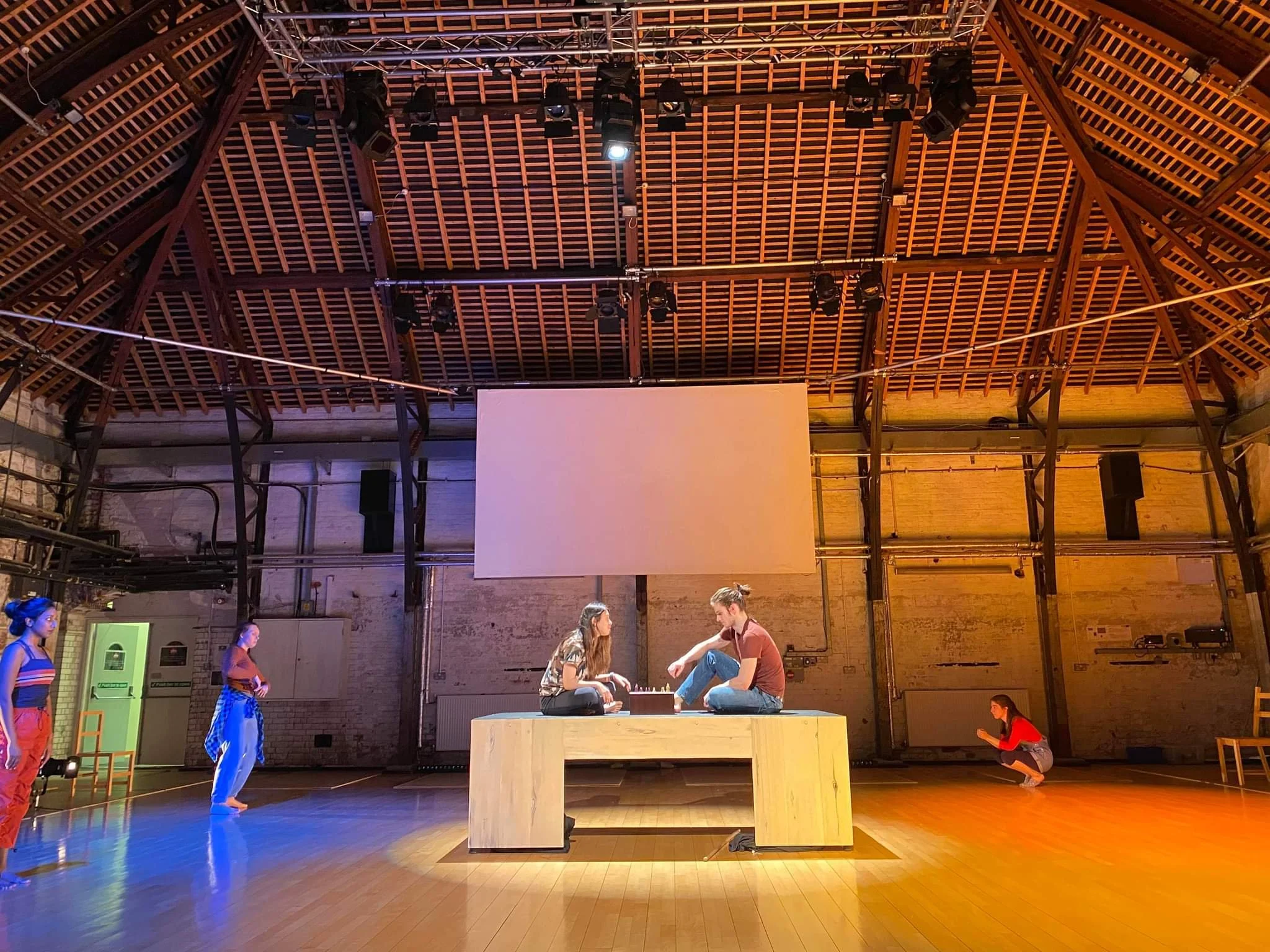The Execution of the Speaker (2022)
The Execution of the Speaker was created for my Final-Year Performance as part of my English and Drama degree at Royal Holloway, University of London. This was performed as part of the short-lived theatre company Jaffa-by-Cakes.
Performed: 24/03/2022 at The Boilerhouse Theatre
Our performance took the form of a piece of physical theatre inspired by the work of DV8, Pina Bausch, and Anne De Keersmaeker. The piece explored social boundaries people have created for themselves and sought to mock the political systems and institutions that seek to divide people further. The Execution of the Speaker delved into the idea of conflict to understand where and how social boundaries form in order to interrogate ideas of social conformity and individuality.
The piece explored these ideas by placing extremely silly, inconsequential arguments into serious; high-stakes settings, such as a debate in the House of Commons about whether Apple Music or Spotify was the superior streaming service. We also debated whether Jaffa Cakes are biscuits or cakes, whether it is better to scrunch or fold toilet paper, how to pronounce the word “scone”, whether it is best to shower in the morning or at night, and much more.
Cast and Crew:
Olivia Davies: Performer, Principal Movement Specialist
Sophie Halse: Writer, Performer
Yu Cheng (Eva) Han: Performer
Eloise Harper: Performer
Vinh (Crystal) Tran Lam: Sound Designer
Xuening (Catherine) Li: Performer
Amaana Mahir: Choreographer, Performer
Elliot Perlic: Director, Technical Liaison, Lighting Designer
Lauren Rider: Performer, Principal Movement Specialist
Yuliia Saihakova: Dramaturg
Pia Saunders-Patel: Performer
Cameron Woodward: Technical Liaison, Performer
For The Execution of the Speaker I took on the role of director, technical liaison, and lighting designer. Below please see more details of my individual contributions to the project in each of these roles.
DIRECTOR
As the director of The Execution of the Speaker, I worked closely with Mahir as the choreographer, and Davies and Rider to ensure we could create a piece that suited the overall vision we were aiming for (to mock institutions and structures that seek to divide people/maintain social divides already in place).
Creating the House of Commons:
Throughout the piece, we constantly return to the setting of the House of Commons. This set posed a challenge because the piece featured a grand table set piece centre stage. We also wanted to keep our set minimal as that was in keeping with our practitioners - particularly Bausch. To solve this problem, I took inspiration from DV8’s “To Be Straight With You” where the set features mostly chairs and it is the movement of the performers that is the main focus of the piece. I knew that Mahir, Davies, and Rider were already taking a lot of inspiration from “To Be Straight With You” and “Can We Talk About This?” as well as Anne De Keersmaeker’s Rosas Danst Rosas for the movement sequences set in the House of Commons, so it made sense that I should use similar inspiration for the set as well.
I also sought to use sound to bring the set to life. The Boilerhouse Theatre - unlike many other theatre spaces I have worked in - is simply an open space with a small sprung floor in its centre. As it result, it lends itself well to pieces of theatre that involve loud noises and dynamic movement. The opening scene of The Execution of the Speaker showed a protest against the government declaring Jaffa Cakes to be biscuits, and the second scene was set during a House of Commons debate. I instructed the performers to use sound as an essential method of transitioning the scene. While the scene was being constructed - all chairs put into place and protest signs placed into the wings - the shouts of protests became the uproarious cries of “hear, hear” so often heard in the House of Commons, particularly during PMQs which the scene sought to imitate.
Creating Powerful Images on Stage:
Because we had a very static set - the only moveable part being a collection of 8 chairs - I sought to work with Mahir, Davies and Rider to create powerful images on the stage where I could combine the set and lighting I had also designed with my blocking of performers to create striking visuals. It was extremely important to me that each scene should have its own unique visual identity and should invoke a different image in the audience’s minds. This was assisted by lighting and set design, but I wanted it to be the case that any still image of the performers should exhibit a specific mood.
I took specific influence from Pina Bausch’s Rite of Spring and Kurt Jooss’ The Green Table when staging each scene. I wanted to make use of the versatility of our simple set and limited props to create scene that would still be visually striking and allowed for lots of freedom of movement for each performer.
For our opening protest scene, I wanted the performers to appear powerful and angry, the bodies themselves should seem to be radiating defiance and the performers should all seem to be willing to tear the world apart.
In the scenes set in the House of Commons, I wanted a structured set to be contrasted by the uncomfortable contortions of the performers - demonstrating the disconnect between the idea of the British parliament as an institution to represent the people and what many see as its reality as a hall filled with those completely separated from those they are supposed to speak for. This should be gradually emphasised throughout the piece as each parliament scene slowly descends further and further into the obscure - ending with the MPs dragging themselves along the floor to reach the speaker’s chair.
During the scene set in an interrogation room, where the police investigate an ‘incident of scrunching [toilet paper] in a public toilet’, I wanted the scene to feel melodramatic. It was the aim to show the ridiculousness of the entire situation. This was also the same aim I wanted to achieve in similar scenes showing domestic disputes around the appropriate time to shower and how to pronounce the word “scone”.
Technical Liaison/Lighting Designer
As the Technical Liaison and Lighting Designer, I was responsible for all technical aspects of the piece including sound, lighting, set design, and costume design. It was not only designing the various technical elements of the piece that I needed to observe, but I was also responsible for making sure these elements of the production were ready in time, constructed properly and safely; and it was my responsibility to liaise with the in-house technical team to ensure a successful production.
Part of this role also made me responsible for creating pre-recorded elements of the production, including filming and editing.
The Permanent Set:
For the permanent set, I took heavy inspiration from Kurt Jooss’ The Green Table, Frantic Assembly’s The Unreturning , both pieces that used one solid setpiece throughout that was extremely versatile and could be used in a multitude of ways. I wanted to create a solid table-like structure in the centre of the stage that throughout the piece would act as a desk, a platform for protesters, a chair, a bed, and the chair for the speaker in the House of Commons.
I envisioned how much space the set would take up and made sure there was still room for the performers to actively move within the space. It was also my desire to cover part of the sprung floor in The Boilerhouse Theatre, enabling us to have props and set pieces closer to the audience. This was in keeping with the venue’s restrictions which stated that elements of the floor which are going to have furniture moved across must be covered by wood panelling.
Sound Cues and Design:
As a member of the technical team, I worked with Tran Lam to select pieces of music that would suit the production. We used two pieces of music in the entire piece: the opening scene used Ben Foster and Murray Gold’s “Captain Jack’s Theme” from BBC’s Torchwood, an explosive action theme; and the remainder of the music was selected exerpts from “Didascalies” by Jean-Philippe Collard and Vincent Royer from The Favourite. “Didascalies” was chosen because it too - as a piece of music - represents the decline into madness and chaos, and the various sections of the piece showcase the varying state of decay present in the House of Commons and the homes of people severely impacted by the issues discussed in the piece.
I collated all the pieces - along with accurate timings for fades and volume adjustments in the software SCS and set it up so that our external sound technician, who operated the technicals of the show with me, could operate based solely on my cues and SCS programming.
Lighting Design:
For the lighting in the production, I instantly knew I wanted to play with shadows and silhouettes. This was a core idea that stuck throughout the creative process. The general rig in The Boilerhouse Theatre allowed for coloured washes and spotlights, but I also introduced floor lights and bar lights to create striking silhouettes and shadows on the floor of the stage and for the audience.
I was inspired by Zoe Spurr’s work on The Unreturning for Frantic Assembly when designing the lighting as I saw first-hand how effective silhouettes can be during scene transitions and to highlight moments in the piece.
I also benefitted from the older technologies in The Boilerhouse Theatre. The theatre’s general rig could provide a coloured wash but it needed to flick through multiple colours to arrive at the wash. The theatre’s technician initally wanted to see how we could adapt this to work with the piece so it wasn’t distracting, but I decided to embrace it because of the piece’s chaotic; unserious nature. I felt, especially during the piece’s final scenes, that this would be a very beneficial technical aspect of the piece.
Overhead lighting was also a very large aspect of the piece. I often aimed to split the stage into section with the use of over spotlights, different coloured washes, or localised blackouts to show isolation in the characters who were opposing each other in our cilly debates.
The Program
I also took on the job of creating the program for the piece that the audience and lecturers watching could use to learn more about the piece. The program had to be on 2 sides of A4 and explain our initial area of research, give a brief overview of the piece, inform of the cast and crew names, and detail which theatre practitioners we drew on.
In keeping with the ideas of the piece, I decided the program should be brightly coloured and unserious. I decided to feature a review from a lecturer who had seen the piece and given feedback, some images of interesting moments in the piece, and make it clear from the off the ridiculous nature of the piece the audience were about to see with the Jaffa-By-Cakes logo and details of some of the debates we would cover during the performance.
Mock News Report
The Execution of the Speaker also featured a mock BBC News report following an announcement that Jaffa Cakes were officially declared as biscuits. The news report was made by myself, Davies and Rider. It stars Davies and Rider and I was responsible for all filming and editing. Please click the link on the right to access the full video of the report.
The mock report was recorded on handheld iPhone cameras and edited in free Windows editing software. The video was made on a minimal budget of less than £10.00 because the only purchase needed was the Jaffa Cakes used during the report.


